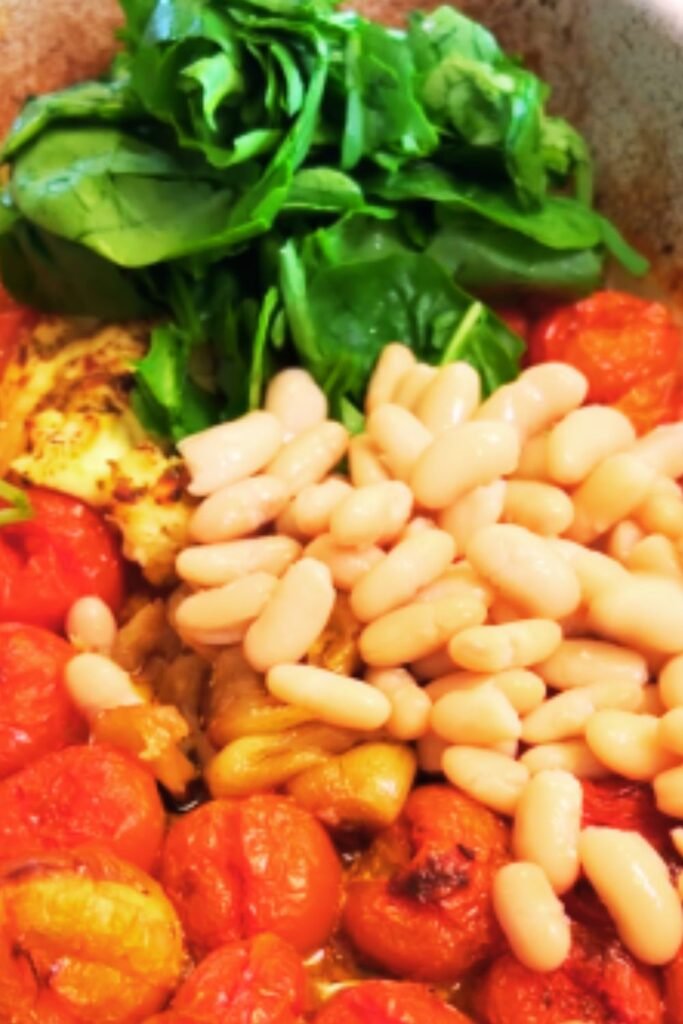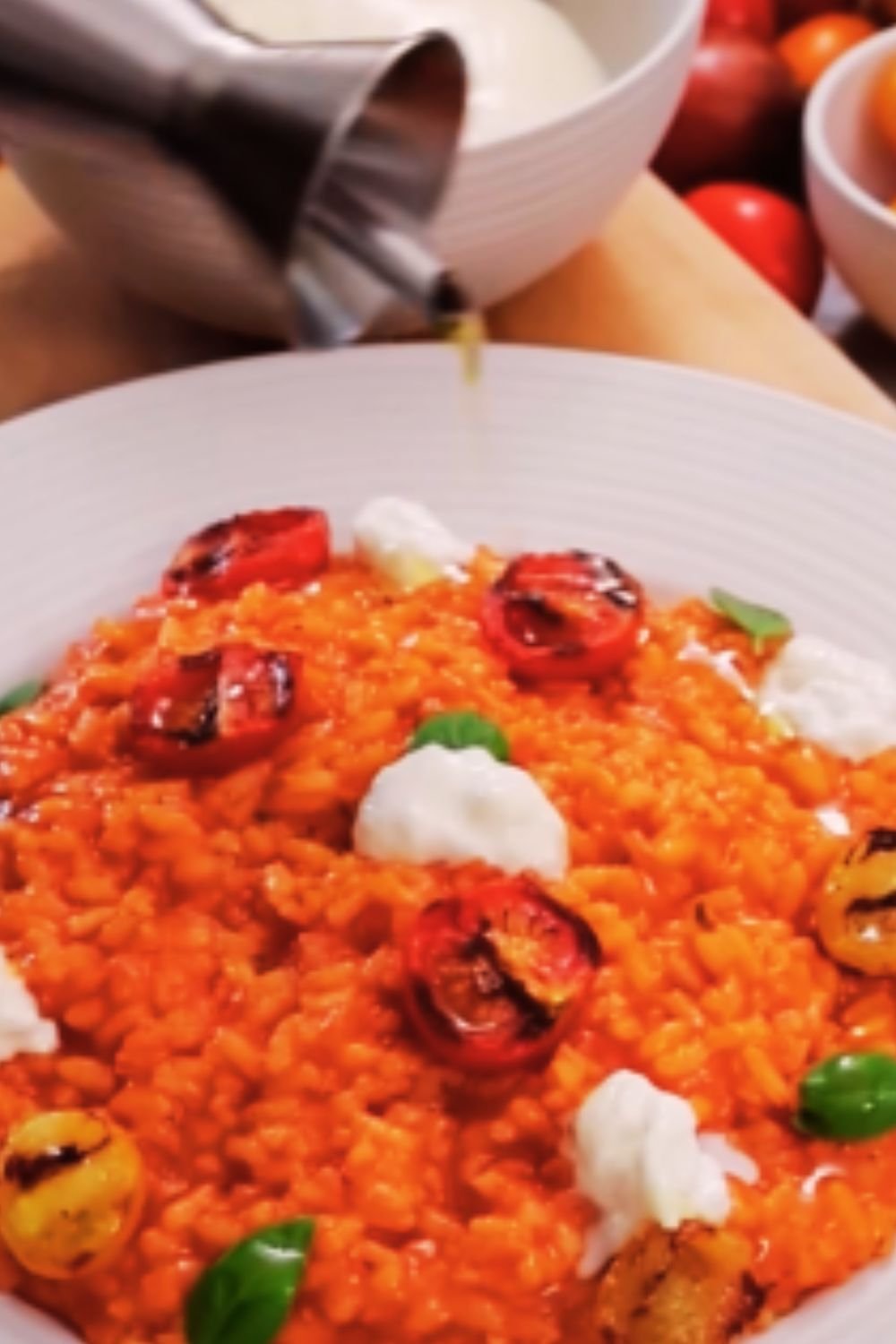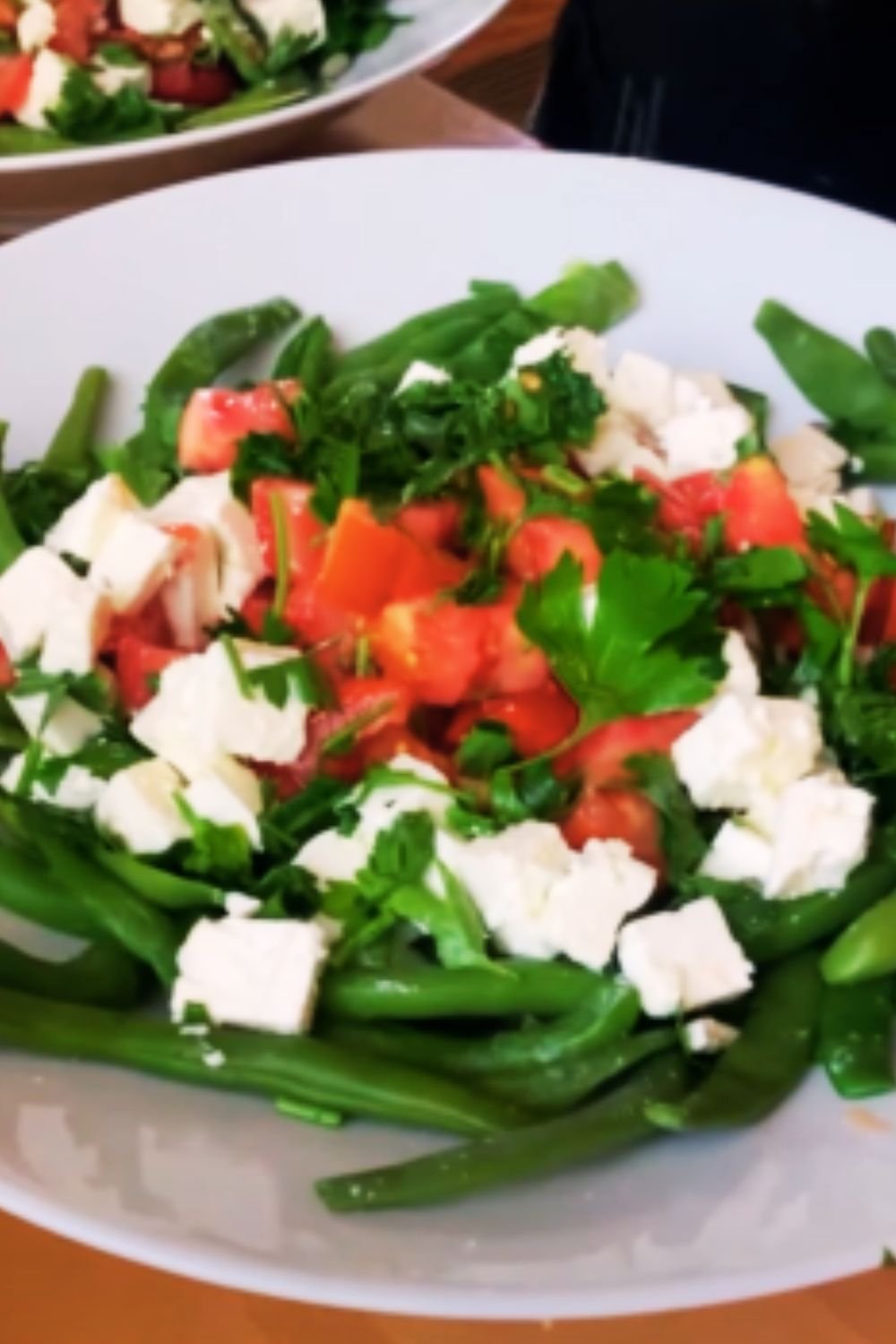There’s something deeply satisfying about a well-made risotto. The creamy texture, the perfect bite of the rice, and the way it serves as a canvas for seasonal flavors. Today, I’m sharing one of my absolute favorite recipes: a Tomato and Roasted Mediterranean Vegetable Risotto that happens to be completely vegan. This dish brings together the sweet, caramelized flavors of roasted vegetables with the rich umami of tomato for a truly memorable meal.
As someone who’s been cooking plant-based meals for over a decade, I’ve learned that vegan food doesn’t have to sacrifice richness or depth of flavor. This risotto proves that point beautifully. The secret lies in the slow, careful building of flavors and the natural creaminess that comes from the starches in the arborio rice—no dairy needed!
Why This Recipe Works
What makes this risotto special isn’t just that it’s vegan—it’s that it uses techniques that maximize flavor at every step. The Mediterranean vegetables are roasted until they develop those delicious caramelized edges. The tomatoes provide acidity and sweetness. And the traditional risotto method coaxes the starch from the rice to create that signature creamy texture we all love.
Before I started developing vegan recipes, I worried that risotto without butter and cheese would feel like a compromise. I couldn’t have been more wrong. This version stands proudly on its own merits, and I frequently serve it to non-vegan friends who always ask for seconds.
Ingredients
For the Roasted Vegetables:
- 1 medium eggplant, diced into 1-inch cubes
- 2 medium zucchini, diced
- 1 red bell pepper, deseeded and diced
- 1 yellow bell pepper, deseeded and diced
- 3 tablespoons olive oil
- 3 cloves garlic, minced
- 1 tablespoon dried oregano
- 1 teaspoon dried thyme
- 1/2 teaspoon red pepper flakes (optional)
- Salt and freshly ground black pepper, to taste
For the Risotto:
- 2 tablespoons olive oil
- 1 large onion, finely diced
- 2 cloves garlic, minced
- 1 1/2 cups arborio rice
- 1/2 cup dry white wine (optional, can substitute with extra vegetable broth)
- 5-6 cups vegetable broth, kept warm on the stove
- 14 oz (400g) can of chopped tomatoes
- 2 tablespoons tomato paste
- 1 teaspoon dried basil
- 1/2 teaspoon dried oregano
- 2 tablespoons nutritional yeast (for cheesy flavor)
- 1 tablespoon lemon juice
- Salt and freshly ground black pepper, to taste
For Garnish:
- Fresh basil leaves, torn
- 2 tablespoons pine nuts, lightly toasted
- Extra virgin olive oil, for drizzling
- Vegan parmesan (optional)
Equipment Needed
This recipe doesn’t require any specialized equipment, but having the right tools makes the process smoother:
- Large rimmed baking sheet for roasting vegetables
- Heavy-bottomed saucepan or Dutch oven for the risotto
- Wooden spoon (important for stirring without breaking the rice)
- Ladle for adding broth
- Small saucepan for keeping broth warm
Nutritional Information
I believe in knowing what goes into your body. Here’s the nutritional breakdown per serving (based on 4 servings):
| Nutrient | Amount per Serving |
|---|---|
| Calories | 485 |
| Protein | 12g |
| Carbohydrates | 78g |
| Fiber | 11g |
| Sugar | 15g |
| Fat | 16g |
| Saturated Fat | 2g |
| Sodium | 620mg |
| Potassium | 980mg |
| Vitamin C | 120% DV |
| Vitamin A | 45% DV |
| Iron | 25% DV |
| Calcium | 8% DV |
Step-by-Step Instructions
Preparing the Roasted Vegetables
- Preheat your oven to 425°F (220°C).
- Wash and dice all your vegetables into approximately 1-inch pieces. Try to keep them relatively uniform in size for even cooking.
- Place the diced eggplant, zucchini, and bell peppers on a large baking sheet.
- Drizzle with olive oil and sprinkle with minced garlic, dried oregano, thyme, red pepper flakes (if using), salt, and black pepper.
- Toss everything with your hands to ensure the vegetables are evenly coated.
- Spread the vegetables out in a single layer, making sure they’re not too crowded. (Use two baking sheets if necessary—crowded vegetables steam rather than roast!)
- Roast in the preheated oven for 25-30 minutes, turning halfway through, until the vegetables are tender and have caramelized edges.

Making the Risotto
While the vegetables are roasting, you can prepare your risotto:
- In a large, heavy-bottomed saucepan or Dutch oven, heat the olive oil over medium heat.
- Add the finely diced onion and cook for 5-7 minutes until translucent but not browned.
- Add the minced garlic and cook for another 30 seconds until fragrant.
- Add the arborio rice to the pan and stir for 2-3 minutes until the grains are glossy and coated with oil. This step is crucial for getting the right texture in your finished risotto.
- If using wine, add it now and stir until completely absorbed.
- Add the canned tomatoes and tomato paste, stirring to combine thoroughly with the rice.
- Begin adding the warm vegetable broth one ladle at a time (about 1/2 cup), stirring frequently until each addition is almost completely absorbed before adding the next.
- After about 10 minutes of adding broth, stir in the dried basil and oregano.
- Continue adding broth and stirring until the rice is al dente—tender but with a slight bite in the center. This usually takes about 18-22 minutes total.
- Once the rice is cooked to your liking, stir in the roasted vegetables, nutritional yeast, and lemon juice.
- Taste and adjust seasonings with salt and pepper as needed.
- Remove from heat and let stand for 2 minutes before serving.
Serving Suggestions
Serve the risotto in warm bowls, garnished with:
- Torn fresh basil leaves
- A sprinkle of toasted pine nuts
- A light drizzle of high-quality extra virgin olive oil
- Vegan parmesan, if desired
This risotto pairs beautifully with:
- A simple green salad with lemon vinaigrette
- Crusty artisan bread
- Grilled asparagus or broccolini
- Marinated olives and other Mediterranean antipasti
Tips for Perfect Results
I’ve made this risotto countless times, and these are the tips I’ve found most helpful for getting consistently excellent results:
Risotto Rice Selection
- Arborio rice is traditional and widely available, but Carnaroli or Vialone Nano rice will give even creamier results if you can find them.
- Never rinse risotto rice before cooking—the starch on the outside of the grains is essential for creating that creamy texture.
The Importance of Patient Stirring
- Stirring releases the starch from the rice, creating the signature creamy texture of risotto without needing to add dairy.
- You don’t need to stir constantly, but stir frequently to prevent sticking and ensure even cooking.
Vegetable Broth Quality Matters
- Use a high-quality vegetable broth—it’s the foundation of your risotto’s flavor.
- I prefer to use homemade vegetable broth when possible, but there are excellent store-bought options.
- My quick homemade broth recipe: Simmer 1 onion, 2 carrots, 2 celery stalks, 2 garlic cloves, 1 bay leaf, and a handful of parsley in 8 cups of water for 45 minutes, then strain.
Perfect Vegetable Roasting
- Don’t skimp on the oil when roasting vegetables—it helps them caramelize properly.
- Make sure your oven is fully preheated before adding the vegetables.
- Don’t overcrowd the pan, or your vegetables will steam rather than roast.
Make It Your Own
- Mediterranean vegetables are traditional, but you can substitute seasonal vegetables.
- Try adding sun-dried tomatoes for an extra burst of flavor.
- A handful of baby spinach stirred in at the end adds color and nutrition.
Seasonal Variations
One of the joys of this recipe is how adaptable it is to the seasons:
Spring Variation
- Replace the Mediterranean vegetables with asparagus, peas, and leeks.
- Add lemon zest for brightness.
Summer Variation
- Use the recipe as written, when Mediterranean vegetables are at their peak.
- Add fresh cherry tomatoes at the end for bursts of sweetness.
Autumn Variation
- Substitute butternut squash, mushrooms, and sage for the Mediterranean vegetables.
- Add a pinch of nutmeg to the finished risotto.
Winter Variation
- Use roasted root vegetables: carrots, parsnips, and beets.
- Add rosemary instead of basil and oregano.

Storage and Reheating
Risotto is best enjoyed fresh, but you can store leftovers:
- Refrigerate in an airtight container for up to 3 days.
- When reheating, add a splash of vegetable broth or water to loosen the texture.
- Reheat gently in a saucepan over medium-low heat, stirring frequently.
- Alternatively, for a different take on leftovers, form the cold risotto into patties and pan-fry them until crispy on both sides for delicious risotto cakes.
The Environmental Impact of Plant-Based Eating
I’m passionate about the environmental benefits of plant-based meals like this risotto. Here’s a comparison of the environmental impact of this vegan risotto compared to a traditional risotto with butter, cheese, and chicken stock:
| Environmental Factor | Vegan Risotto | Traditional Risotto |
|---|---|---|
| Water Usage | 1,200 gallons | 2,800 gallons |
| Carbon Emissions | 2.3 kg CO2e | 5.6 kg CO2e |
| Land Usage | 3.2 m² | 7.5 m² |
By choosing plant-based dishes like this one, we can significantly reduce our environmental footprint while enjoying delicious, satisfying meals.
The Health Benefits of Mediterranean Ingredients
The Mediterranean diet, which inspires this risotto, is renowned for its health benefits. Here’s a breakdown of some key ingredients in this recipe and their beneficial properties:
| Ingredient | Key Benefits |
|---|---|
| Eggplant | Contains anthocyanins that protect cells from damage |
| Bell Peppers | Rich in vitamin C and antioxidants |
| Tomatoes | Contain lycopene, which may reduce cancer risk |
| Olive Oil | Heart-healthy monounsaturated fats |
| Garlic | Anti-inflammatory and immune-boosting properties |
| Herbs (Basil, Oregano) | Provide antioxidants and anti-microbial benefits |
Making Ahead for Entertaining
When I’m hosting dinner parties, I use these strategies to prepare components in advance:
- Roast the vegetables up to 2 days ahead and store in the refrigerator.
- Prepare your vegetable broth and keep it refrigerated for up to 3 days.
- Chop the onions and garlic the morning of your event.
- For serving, prepare the risotto up to the halfway point, then pause. Resume cooking about 15 minutes before you want to serve.

A Note on Vegan Parmesan Alternatives
While this risotto is delicious without any cheese substitutes, I sometimes like to add a sprinkle of vegan parmesan for that extra special touch. Here are some options:
- Store-bought vegan parmesan (many brands now make excellent versions)
- Homemade nut-based parmesan (blend 1 cup cashews, 4 tablespoons nutritional yeast, 1 teaspoon garlic powder, and 1/2 teaspoon salt in a food processor until fine)
- Toasted and ground pumpkin seeds mixed with nutritional yeast
- Breadcrumbs toasted with herbs, nutritional yeast, and olive oil
Q&A Section
Q: Can I make this risotto without wine? Absolutely! The wine adds acidity and depth, but you can substitute an equal amount of vegetable broth with a squeeze of lemon juice to achieve a similar effect.
Q: My risotto seems too thick. What should I do? Simply add a bit more warm broth or even water, stirring until you reach your desired consistency. Remember that risotto continues to thicken as it sits, so it’s better to err on the slightly loose side.
Q: How can I tell when my risotto is done? Perfect risotto should be creamy but not mushy. The rice should have a slight bite to it—what Italians call “al dente.” The best way to check is to taste a grain: it should be tender on the outside with a tiny bit of firmness in the center.
Q: Is arborio rice the only rice I can use for risotto? Arborio is the most common and widely available risotto rice, but Carnaroli and Vialone Nano are even better choices if you can find them. They have a higher starch content that creates an even creamier risotto.
Q: My risotto seems to be taking forever to cook. What am I doing wrong? The most common issue is that your broth isn’t hot enough. Keep it simmering gently in a separate pot while you add it to the rice. Cold broth slows down the cooking process significantly.
Q: Can I freeze this risotto? While you can freeze risotto, the texture will change somewhat upon thawing and reheating. If you plan to freeze it, I recommend slightly undercooking the rice, cooling it quickly, and freezing in airtight containers for up to 1 month. Thaw overnight in the refrigerator and reheat with additional broth to restore creaminess.
Q: Do I really need to stir constantly? You don’t need to stir literally every second, but frequent stirring is essential. It helps release the starch from the rice to create the creamy texture risotto is known for. It also prevents the rice from sticking to the bottom of the pan and ensures even cooking.
Q: What’s the purpose of nutritional yeast in this recipe? Nutritional yeast adds a savory, slightly cheesy flavor to vegan dishes. In this risotto, it helps replicate some of the umami notes that would traditionally come from parmesan cheese.
Final Thoughts
This Tomato and Roasted Mediterranean Vegetable Risotto is more than just a meal—it’s a celebration of simple, high-quality ingredients coming together to create something truly special. The combination of sweet roasted vegetables, tangy tomatoes, and creamy arborio rice makes for a dish that’s greater than the sum of its parts.
What I love most about this recipe is its versatility. You can adapt it based on what’s in season or what you have on hand. The technique remains the same, but the flavor possibilities are endless.
Whether you’re a longtime vegan, experimenting with plant-based meals, or simply looking for a delicious dinner option, I hope this risotto becomes a favorite in your recipe collection. It certainly has in mine!


